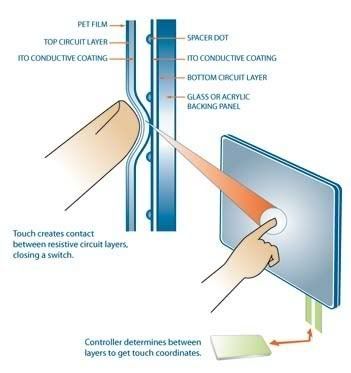1. Resistive Touchscreen:
Resistive touchscreens are the most widely used touch screens in mobile phones. They are cheap and resistant to water and dust, but they get easily scratched and cannot be used with sharp objects. You can use any object to touch it, for instance finger, stylus, etc. You need to apply a bit of pressure in order to press the touchscreen. They have a good lifespan of about 35 million clicks.

Examples of Resistive touchscreens: HTC diamond, LG Viewty
2. Capacitive touchscreen:
Capacitive touchscreens are basically of two types- one that can recognize multiple touches simultaneously and the other which cannot. These type of touchscreens are costlier than the resistive types. They are scratch, moisture and dust-proof.

It has an extremely long life of about 225 million clicks. In addition to this it lets through about 92% of the light emitted by the screen. There’s one serious disadvantage- it can’t be touched with just any object that you may like.
Examples of Capacitive touchscreens: Apple iPhone, LG Prada, Samsung F480
3. Infrared touchscreens:
Infrared touchscreens are the most expensive of the all the three mentioned here. It doesn’t require physical force, just a gentle touch is enough. In addition to this it is not influenced by dust, moisture or scratches. Moreover it’s the most durable compared to the other ones. They are basically of two types: optical and heat-sensitive.
This optical type uses infrared beams, which are not visible to the human eye. It works, using a number of sensors, arranged above and around the screen, forming a grid of invisible beams. If an object (finger or a stylus) touches the display, it interrupts the rays in a certain area and thus the touch point is determined. It has a lifespan of about 7 years. It suffers from a serious disadvantage- a strong ambient light can have a negative impact on its productivity.
The heat-sensitive type is the widely used one, but it is rarely used in screens. It is applied in other components of mobile devices like buttons. The best examples are Samsung SGH-E900 and Samsung U600, which can only be touched with warm objects. It suffers from one serious drawback- If your finger is frozen in winter and you touch this phone it won’t respond to your finger as its cold.


No comments:
Post a Comment